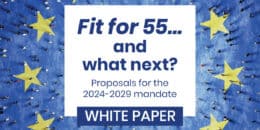In the context of the Green Deal, the European Commission has announced that the EU will soon be raising its GHG emission reduction target for 2030 from 40% to 50 or 55% in view of achieving climate neutrality in 2050. In order to adapt the European legislative framework to these new targets, the Commission will publish during summer 2020 a Comprehensive Plan announcing a series of revisions.
EdEn (Equilibre des Energies) supports this increased ambition as well as the legislative revision process that will follow. In order to align the building sector with these climate objectives, we recommend that the Energy Performance of Buildings Directive (EPBD) should also be included in the revision package. This paper identifies the shortcomings of the current EPBD and the solutions that should be implemented to tackle them. In particular it highlights that:
• The current text of the EPBD is not in line with the EU’s climate commitments as it does not include any mandatory GHG reduction provision despite the building sector accounting for approximately 36% of GHG emissions in the EU ;
• Relying solely on the energy performance criteria will not make it possible to achieve full building stock decarbonization;
• Measuring the energy performance of buildings in primary energy use hampers the decarbonisation of the building stock.







